22 EPIC Lebanese vegetarian dishes • from a local! (2024)
Find comfort in food with our healthiest, most delicious Lebanese dishes. Read on for plant-based goodness.
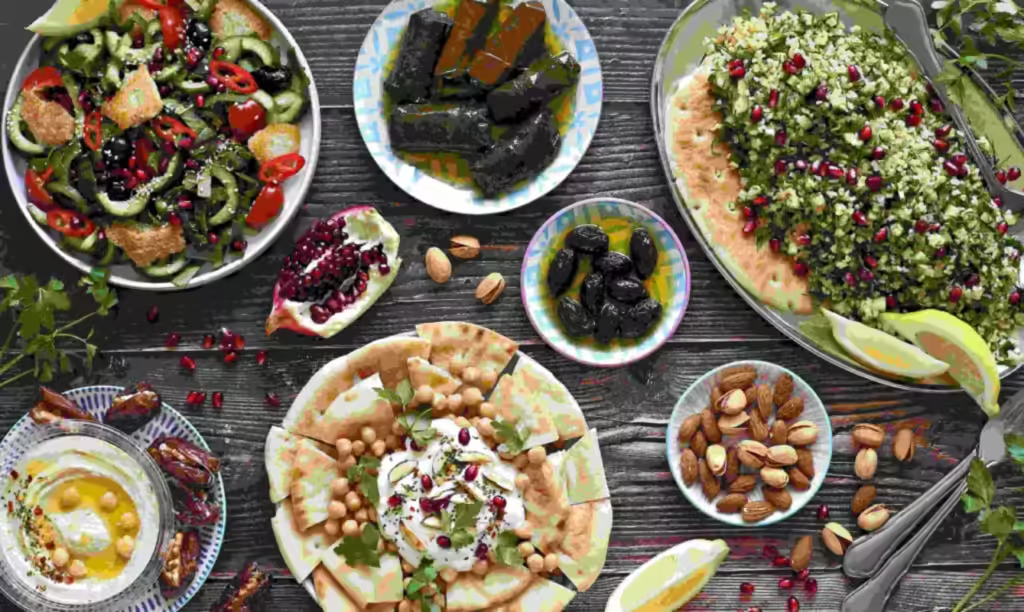
On the hunt for the BEST Lebanese vegetarian dishes to impress your friends? You’re in the right place!
I lived in Beirut for a year and have been traveling between Lebanon and the UK for over 10 years now, so I’m an expert when it comes to the best Lebanese food ever. I’ve got you!
I’ll cover mezze dishes, salads, mains, and dips – click on these links to scroll straight down!
No time to scroll? Here are my all-time favorite Lebanese vegetarian dishes!
Most popular dish – falafel
Top choice for picky eaters – batata harra
Best vegetarian dish for brunch – fatteh
All-around best salad – fattoush
Best Lebanese main dish for protein – mujaddara
Top vegetarian comfort food – spaghetti bi laban
Most versatile dip – toum
1. Lebanese vegetarian mezze & side dishes
Mezze dishes are small sharing plates that are super popular in Lebanon, as well as across the Middle East. It’s traditional to eat mezze before the main course!
Batata harra
Batata harra is a dish of delicious, spiced potatoes. It’s super simple to make and perfect for those picky kids!
This might become your all-time FAVORITE way to make potatoes. And you can use it as a side dish for almost anything!
Get the recipeFatteh
Fatteh is my husband’s favorite brunch dish! Being Lebanese, he knows the best food on offer, so take it from him!
Fatteh is a layered, yogurt-based dish with fried flatbreads or pita bread, chickpeas, and a tangy garlicky sauce. YUM!
You can top your fatteh with anything you like – my husband loves eggplant and pine nuts, but mint, pomegranate seeds or just some extra crispy roasted chickpeas will do the trick.
Make fattehFatayer
These savory little pies will have you reaching for more, I promise!
Fatayer are traditionally filled with spinach, onions, and lemon juice among other things. They’re similar to sfeeha and are super popular during Ramadan.
My mother-in-law makes the BEST fatayer, honestly I could eat them all day, every day. It’s commonly served for breakfast.
Want to see more Lebanese breakfast recipes? I don’t blame you! Check out my post for the 14 TOP Lebanese breakfast dishes for a healthy heart!
try your hand at fatayerI highly recommend making the dough from scratch, even if you’re not a confident chef. It’s a super easy process and they won’t be the same with store-bought dough!
Falafel
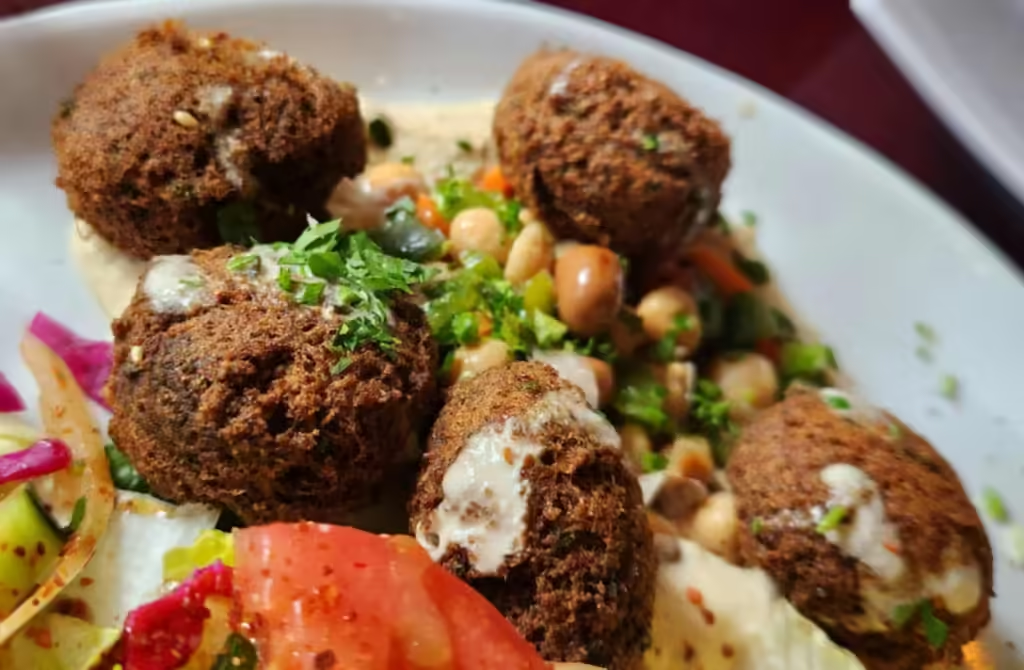
One of the vegetarian kings of the Middle East, falafel is sexy and knows it!
Falafel is deep-fried, chickpea based spice balls traditionally eaten in a wrap with a tahini sauce, pickled turnips, and salad. YUM!
Falafel can be difficult to make if you’re doing it the traditional way, but it’s so worth it.
Some nations may argue about the origins of Falafel, but empirical evidence suggests that falafel originated somewhere in Egypt. It’s typically enjoyed as a casual street food and perfect for a quick bite!
Waraq enab bi zeit
Waraq enab (pronounced wa-ra-eye-nab in Lebanese Arabic) is traditionally a meat-based dish, but there is a vegetarian version that’s arguably even tastier!
This dish consists of a rice and vegetable mixture wrapped in grape leaves and slowly steamed until soft and divine.
It also freezes well, so don’t be afraid to make a big batch!
You won’t find vine leaves in most stores, so buy them here for ease.
PRO TIP: It may take some effort to learn how to roll the vine leaves to ensure the filling doesn’t fall out. Pay attention to the video and practice, but it’s so worth it!
Get the recipeRaqaqat jebne (cheese rolls)
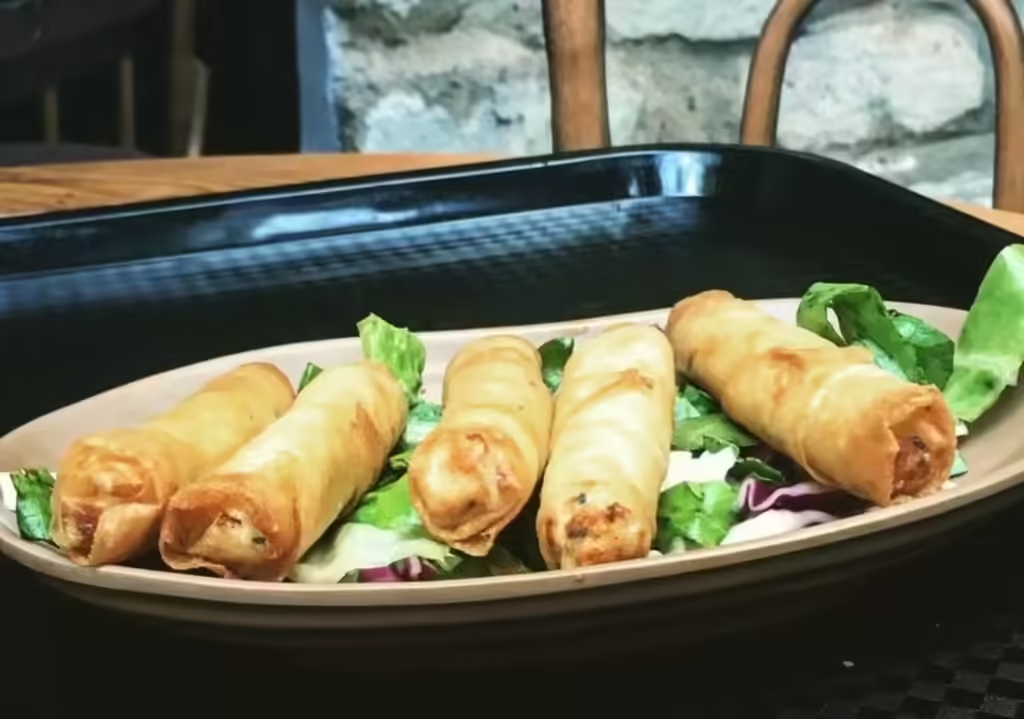
Cheese rolls do exactly what it says on the tin. They are rolls of cheese. And they are AMAZING.
Cheese rolls and gin basils are my Lebanese duo of dreams. Sadly, it’s hard to find the REAL cheese rolls anywhere but Lebanon, so make your own!
Traditionally, Lebanese people use akkawi cheese to make these. Akkawi is a salted white cheese you’ll be able to find in most Middle Eastern or Eastern European stores, so don’t substitute it!
make cheese rollsThe first cheese roll I tried was in a restaurant in Beirut, and I absolutely died of pleasure. Since then, I have spent more time thinking about cheese rolls than most other things.
2. Lebanese vegetarian salad dishes
Salads are a great addition to any table, but the Lebanese table does it best!
Fattoush
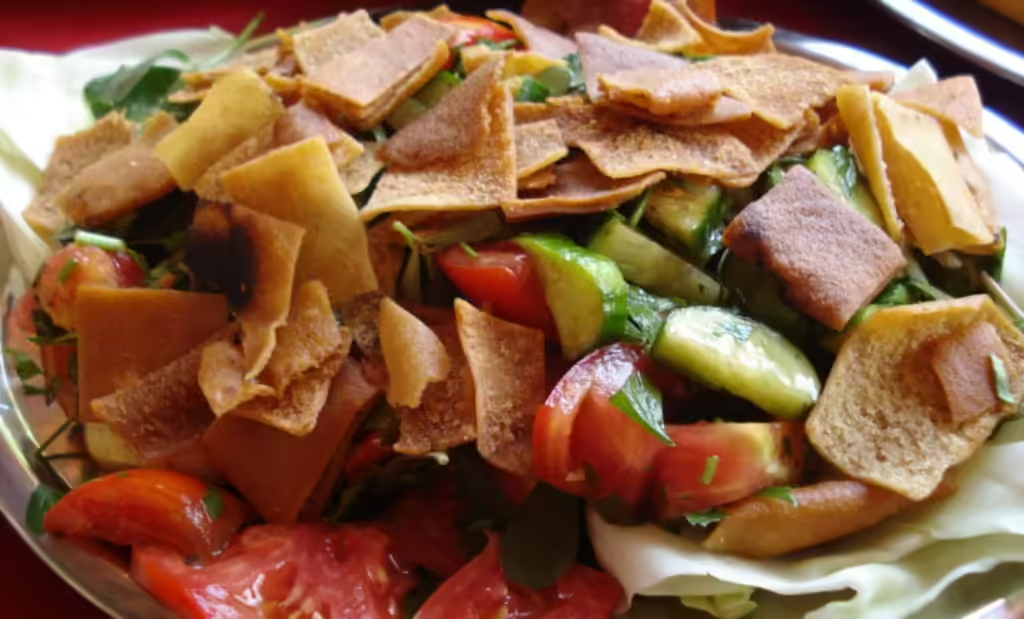
Fattoush is THE reigning queen of salads, topped with crispy flatbread and drizzled in pomegranate molasses and a sumac-olive oil dressing.
It has a typical base of tomatoes, cucumber and lettuce. The bonus? It’s vegan-friendly!
This Lebanese salad is super simple to make and takes 10 minutes, so it’s great for a midweek side dish.
Not sure where to find pomegranate molasses? It might be expensive in some stores, so get it cheaper here.
get the recipeTabbouleh
There are so many versions of tabbouleh out there, but the real deal is actually a bit time-consuming to make. The parsley needs to be washed, stored, and rewashed a few times before it should be chopped.
My advice? Don’t take a shortcut! Use the washing and chopping as a mindful exercise and the end result will be absolutely incredible.
- 3 bunches of flat leaf parsley
- 1 bunch of mint
- 4 spring onions
- 1/4 large onion
- 2 large tomatoes (~500 g)
- 3 tbsp fine bulgur wheat
- 1/2 cup lemon juice
- 1/4 cup + 2 tbsp extra virgin olive oil
- 1 1/4 tsp salt
- Pinch of black pepper
Want to learn Arabic so you can understand the recipes from Lebanese experts themselves? Path to Arabic is perfect for all types of learners! Get a huge discount on their classes, with love, from me! Find your options here.
get the recipe on youtubeHindbeh bi zeit

Think this is a plate of spinach? It’s not – it’s actually dandelion leaves with onions.
I’m not kidding when I say this dish is absolutely incredible. One serving just won’t be enough!
Dandelion leaves are full of antioxidants! They’re super anti-inflammatory and can also help with digestion, so it’s a fantastic vegetarian side dish for those who suffer from IBS.
Coriander haters be warned – you need it for this dish! 🤪
Salatat malfouf
This isn’t just a cabbage salad. This is the ULTIMATE cabbage salad!
It’s so simple to make, and so full of healthy goodness. Malfouf can be the perfect addition to almost any meal, it’s that versatile!
The best thing about this salad is how cheap it is to make. Cabbage is one of the cheapest vegetables to buy, so in this economy, it’s a lifesaver!
get the recipe here3. Lebanese vegetarian main dishes
Now for the best part! I hope you saved some room after all that mezze, because the creme de la creme of Lebanese cuisine is about to come.
Mujaddara
Mujaddara is a rich dish made with rice and lentils, and it’s super healthy and filling!
It’s also really cheap to make, so it’s great for those right-before-payday-meals we all know too well.
PRO TIP: Cumin is usually the main spice used for mujaddara, but I also like to add in a tablespoon of 7 spice as well just to give it more depth of flavor. You might not be able to find 7 spice in your local store, so just buy proper stuff here!
watch how to make itMeat-free kousa mahshi
Kousa mahshi is stuffed zucchini in a tomato-based sauce made with tomato paste and stock. As far as Lebanese recipes go, this is a staple in most families!
Traditionally, kousa mahshi is made with rice and ground beef. But the vegetarian version leaves the recipe open to whatever you fancy! A mixture of rice, chopped fresh vegetables, and a plethora of herbs can be used, making it totally versatile.
Stuffed vegetables for the win!
get the recipeShakshuka
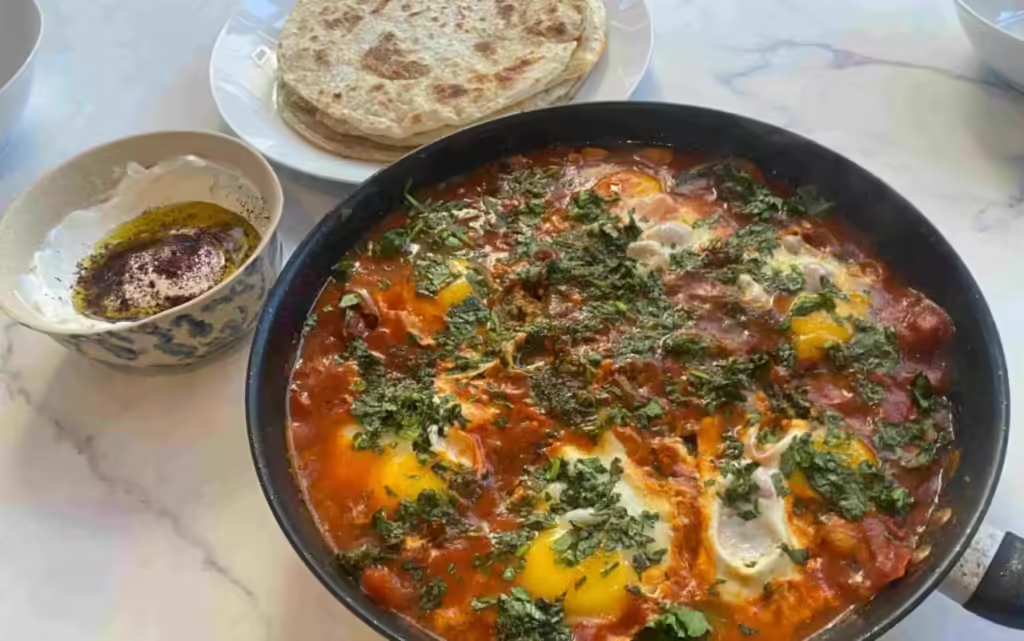
Shakshuka technically originates in North Africa, and although you won’t find shakshuka in your Lebanese grandma’s cooking journals, it’s still served in restaurants across the country.
Shakshuka is a simple dish of eggs cooked to perfection in a tomato sauce.
You can alter the recipe to include any vegetables you like, but it’s traditionally served as a spiced tomato and onion sauce with peppers, eggs and a topping of parsley/coriander and feta. YUMMM!
The image above is a shakshuka I made for my husband, and it went down a treat. No leftovers at all!
PRO TIP: Add chili for a kick and sugar to cut through the tomatoes’ acidity!
see the processSpaghetti bi laban
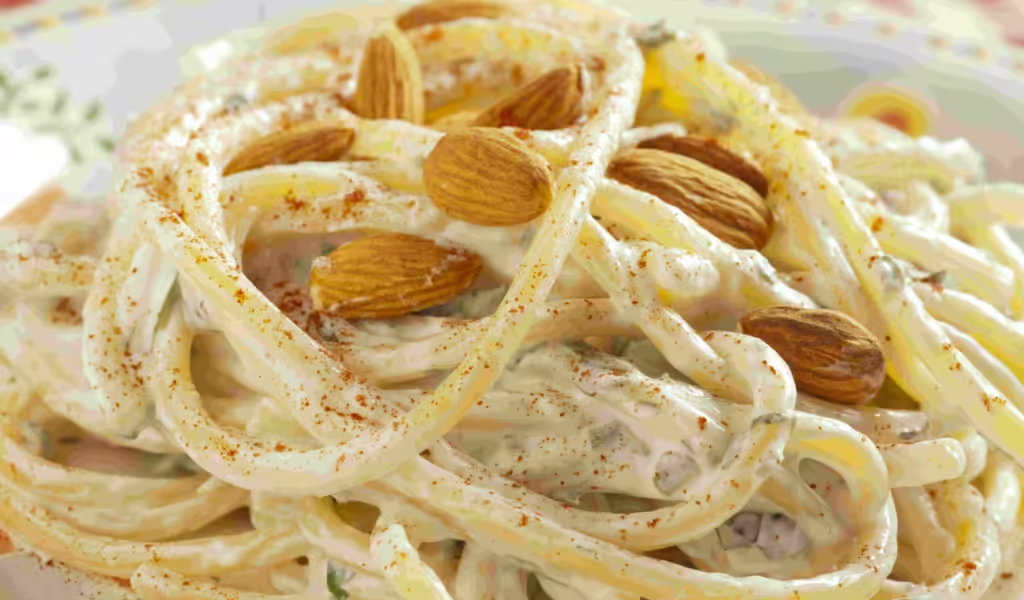
Another of my husband’s favorites! This might seem like a strange dish, but it’s a real gem, and a comfort food enjoyed by all home cooks in Lebanon!
Spaghetti bi laban is literally just…spaghetti in yogurt sauce.
Bear with me!
It may sound simple, but with a topping of olive oil, lightly-fried pine nuts, roasted garlic, and freshly chopped mint, you’ve got yourself a healthy comfort food you won’t be able to stop eating.
Hadia’s Lebanese Cuisine does it best!! Her recipe doesn’t include the pine nuts but I highly recommend adding them. It takes literally minutes, so you’ve got a simple midweek meal in no time!
get the recipeLoubieh bi zeit
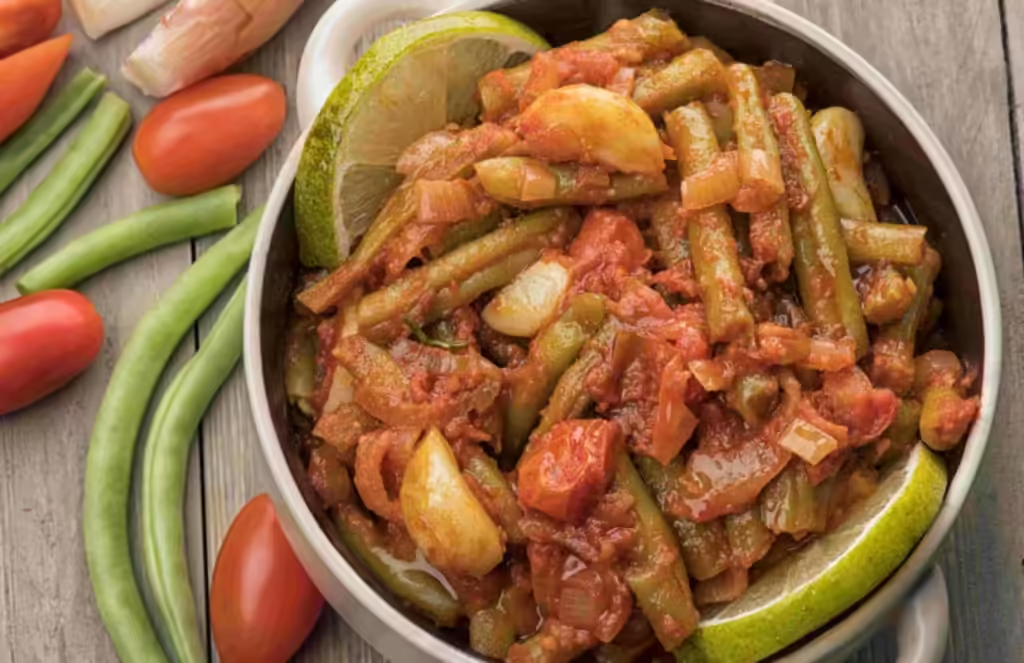
Loubieh is the fastest, most amazing vegetarian dish for those who love simplicity and the prospect of vegan Lebanese recipes!
It’s so simple that the only things you need for this recipe are green beans, tinned cherry tomatoes, olive oil, and garlic. Use a few seasonings, of course – but the simpler the better!
The question is, who does it best?
Palestine Dish does! However, they use string beans as is tradition in Palestine – I recommend using Romano beans for this recipe if you want to bring out your inner Lebanese teta!
make loubieh bi zeitShorbat adas
What is a soup doing here as a main dish?
Because it’s lentil soup!
Lebanese lentil soup is super filling. You can eat it with fresh bread and one of the salads above, and it makes for the most perfect meal.
It’s also full of protein – every cup of red lentils amounts to a whopping 18g of protein, so if you’re looking for gains, this is IT!!
PRO TIP: If you want to make shorbat adas thicker, add a potato and blend it with a hand blender.
see how it’s doneBamya
Traditionally served with stewing beef, Bamya is okra stew that you can eat with fluffy Lebanese rice (see an amazing recipe for Lebanese rice here).
You can easily use frozen okra for this, and the sauce is just divine. Okra is sometimes difficult to find in stores, so buy super cheap frozen Okra here!
Okra has numerous health benefits, including aid in digestion, promotion of heart health, and it’s even known to help diabetics manage their blood sugar levels!
get the recipe4. Lebanese vegetarian dips
Lebanon is famous for the best dips in the world! From garlic sauce to tahini-based deliciousness, you’ll find something for every mealtime.
Toum
This is my ALL-TIME FAVORITE DIP IN THE WHOLE WORLD.
Toum is garlic sauce, and no, it’s not as simple as adding garlic to mayo. In fact, the proper way to make it is with lemon juice and vegetable oil, so you’re kind of making your own mayo during the process.
You can eat this with anything – meat, fish, wraps, roasted veggies, whatever the hell you’re making, there should ALWAYS be a spot for toum on the table.
One of my favorite things to do in Beirut is head over to Makhlouf in Dawra and have a shawarma with a ton of toum. It’s unreal! Fancy a trip to Beirut as well? Check out my post for all the most amazing ways to spend time in the city!
PRO TIP: Make loads, it’ll be gone in no time!
See how to make toumMuhammara
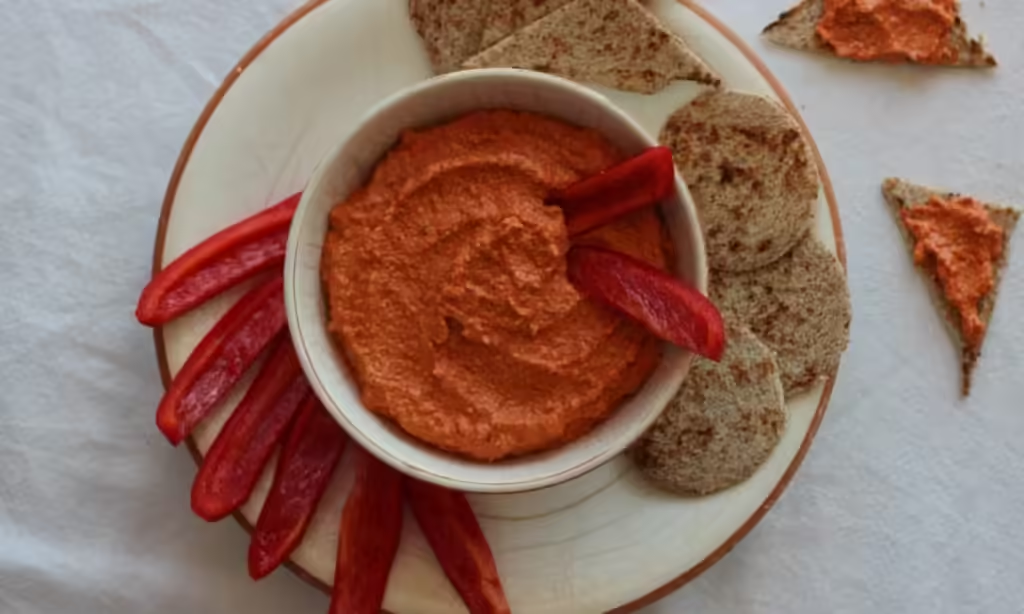
My friend Viviane, another Lebanon local, absolutely adores muhammara, a walnut and pepper-based dip with pomegranate molasses and tahini.
This is a super healthy recipe, and if you’re tired of eating hummus, it makes for a nice change!
Once again, Hadia does it best, so check out her recipe below!
go to recipeMutabal
Mutubal is similar to baba ganoush, with one glaring difference: there’s no tahini in babagan, but it’s essential in mutabal!
This smoked eggplant dip is so healthy and has so much depth of flavor. And all you need is:
- Eggplant
- Tahini
- Labneh (or Greek yogurt)
- Lemon juice
- Salt
I personally think mutabal is far nicer than baba ganoush. Its smoky, deep flavor is unmatched.
watch how it’s doneHummus

Hummuuuuuuus. I could write songs about hummus. It’s just so versatile, so tasty, and the store-bought stuff just isn’t as good as the homemade stuff.
I’ve tried SO many recipes over the years, and I finally found one that works!
Here’s my coveted hummus recipe:
- Use dried chickpeas (about 400g) and soak them in water overnight in the fridge
- The next day, boil your chickpeas until their little jackets mostly fall off
- Discard most of the water (except for about 3 tablespoons)
- In a food processor, blend the chickpeas with the leftover chickpea water until it looks like a mulch
- Add 1 ice cube, a clove of garlic, a sprinkle of salt, a heaped tablespoon of tahini paste
- Blend until smooth – if needed, add a drizzle of olive oil during the process to make the hummus even creamier
TOP TIP: Once your hummus is served, use a spoon to make wells in the dip and pour some olive oil over the top. Add some sumac for an extra glimpse of Lebanon!
Looking for a food processor? My favorite processor is this little one from Kitchen Aid.
It does the job for chopping vegetables, making dips like hummus and toum, and even pesto. I’ve had it for years and never had a problem with it. It’s also the perfect size, being small enough not to take up much room. Convenience for the win!
get your kitchenaid food processor!Labneh
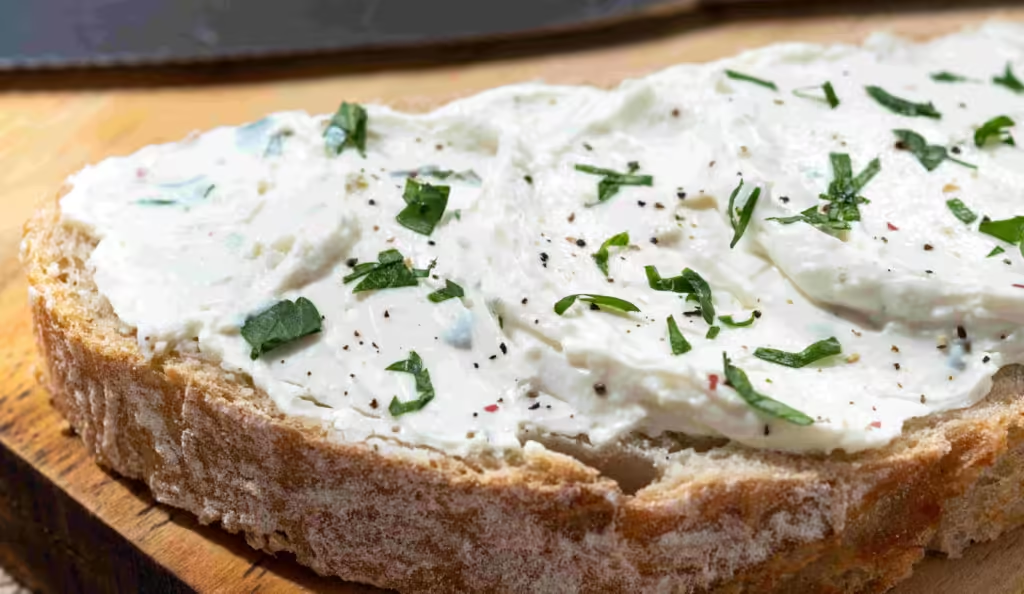
Labneh is the king of simplicity.
Labneh is just yogurt that has been strained through a cheesecloth until slightly sour and super thick. Not to be confused with laban (which is just Arabic for yogurt), labneh is perfect with eggs, on toast, with pasta, as a dipping sauce, or as a side dish with flatbread.
You don’t need to make labneh as long as you can find it in your local Arab store. Eastern European shops also sell it! If you can’t find it, I recommend Karoun’s labneh!
get your delicious labnehFAQS about Lebanese vegetarian dishes

🍆 Is Lebanese cuisine vegetarian-friendly?
Yes! Although most Lebanese people consume meat every day, the dishes lend themselves to vegetarians very easily. Fun fact – most Lebanese people see a difference between meat and chicken, so if you tell people you’re vegetarian, they might ask if you eat chicken!
🥕 Is Lebanese food good for vegans?
Lebanese food is very good for vegans. You may need to alter some of the ingredients on occasion, but you can “veganize” most Lebanese food in some way.
🇱🇧 What is Lebanon’s national dish?
Lebanon’s national dish is kibbeh, which is a meat-based dish. However, you can make a vegetarian version using pumpkin – see the recipe here!
🥫 What percentage of Lebanon is vegetarian?
Although meat consumption in Lebanon has decreased by about 30% in recent years, full-on vegetarianism is still relatively rare, at around 4% of the population.
Conclusion
Phew! Now you know the TOP Lebanese vegetarian recipes, let me know which ones you’re going to make in the comments!
If you’re looking for more, don’t forget to check out my all-things-Lebanon page for the top tips and most amazing food.
Peace out veggies!
Lizzie
